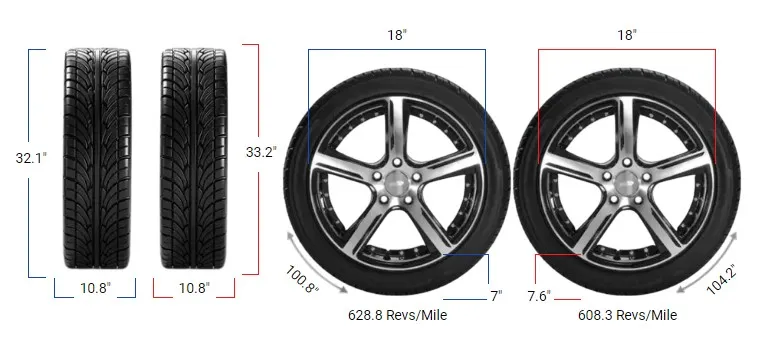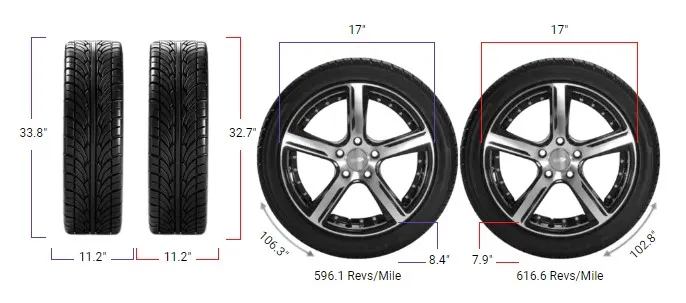Tire Size 255/60r15 vs 275/60r15
 Switching from a 255/60r15 to a 275/60r15 tire means choosing a wider and slightly larger tire. While there are benefits like improved traction and a more commanding look, there are also potential downsides such as increased fuel consumption and fitment challenges.
Switching from a 255/60r15 to a 275/60r15 tire means choosing a wider and slightly larger tire. While there are benefits like improved traction and a more commanding look, there are also potential downsides such as increased fuel consumption and fitment challenges.
- The 275/60R15 offers a larger diameter for improved ground clearance
- The increased sidewall height provides better cushioning on rough roads
- The larger circumference can improve stability during highway driving
- Fuel efficiency may decrease due to the increased tire size and weight
- The wider tire can give the vehicle a more aggressive and rugged appearance
- A reduction in revolutions per mile may affect speedometer accuracy

Fitment Guide
Replacement tires must be within 3% of the original tire’s overall diameter. In this case, the diameter difference is 3.5%, which exceeds the acceptable range.
This means the interchange is not recommended without making necessary adaptations.
If you still choose to switch, you may need to modify your vehicle to prevent issues like rubbing or clearance problems, such as adjusting the suspension or using wheel spacers.
On-Road Impact
Changing tire sizes can significantly influence your daily driving experience. Here’s what to expect when you’re on the road:
Gas Mileage
Upgrading to a wider tire like the 275/60r15 can reduce gas mileage. The increased width leads to higher rolling resistance, meaning your vehicle may consume more fuel, especially during highway driving where efficiency is crucial.
Ride Comfort
The 275/60r15 has a taller sidewall by 0.47 inches. This provides more cushioning between the wheel and the road, potentially offering a smoother and more comfortable ride.
However, the wider tire might also make the ride feel less supple compared to the narrower option.

Speedometer Accuracy
A larger tire diameter affects your speedometer readings. For example, when your speedometer reads 20 mph, your actual speed is about 20.7 mph.
This slight overestimation means you could unknowingly drive faster than intended, so it’s important to be mindful of the difference.
Durability & Wear
The 275/60r15 tire, being wider, may experience increased wear on the edges if not properly aligned. Ensuring regular maintenance and alignment checks can help mitigate premature tire wear.
Additionally, the larger size might contribute to greater stress on your vehicle’s suspension components over time.
Aesthetics Look
A wider tire like the 275/60r15 can give your vehicle a more aggressive and robust appearance. The increased width fills out the wheel wells better, enhancing the overall aesthetic appeal. If you prefer a bold look, this change can significantly improve your vehicle’s stance.
Off-Road Impact
Changing tire sizes also affects how your vehicle handles off the beaten path. Here’s how the switch influences off-road performance:

Ground Clearance
Switching to the 275/60r15 slightly increases ground clearance by 0.94 inches. This can be beneficial when navigating over rocks, logs, or uneven terrain, reducing the risk of undercarriage damage and improving overall off-road capability.
Traction
The wider 275/60r15 tires provide a larger contact patch with the ground, enhancing traction on loose surfaces like mud or sand.
This improvement can lead to better handling and stability when driving off-road, making your vehicle more capable in challenging conditions.
Vehicle Capability
A larger and wider tire can improve your vehicle’s towing and hauling capacity. The increased diameter and width offer better support and stability when carrying heavy loads or climbing steep inclines, enhancing overall vehicle capability both on and off the road.
Aesthetics Look
Switching to the 275/60r15 can give your vehicle a more rugged and commanding presence. The wider and larger tires make your car look more capable and off-road ready.
However, some may find the change less appealing if they prefer a more streamlined or fuel-efficient appearance.
255/60r15 vs 275/60r15
This table compares the key features of tire sizes 255/60R15 and 275/60R15.
| Feature | 255/60R15 | 275/60R15 | Difference |
|---|---|---|---|
| Diameter inches (mm) | 27.05 (687) | 27.99 (711) | 0.94 (24) 3.5% |
| Width inches (mm) | 10.04 (255) | 10.83 (275) | 0.79 (20) 7.8% |
| Circumference inches (mm) | 84.97 (2158.27) | 87.94 (2233.67) | 2.97 (75.4) 3.5% |
| Sidewall Height inches (mm) | 6.02 (153) | 6.5 (165) | 0.47 (12) 7.8% |
| Revolutions per mile (km) | 745.66 (463.33) | 720.49 (447.69) | -25.17 (-15.64) -3.4% |
| Speedo Reading | 20 mph (32.19 km/h) | 20.7 mph (33.31 km/h) | +0.7 mph |
Difference Between 255/60R15 and 275/60R15
The primary difference is width. A 275/60R15 tire is 0.79 inches (20 mm) wider than a 255/60R15, enhancing traction but may affect wheel clearance and vehicle handling.
Can I Use 275/60R15 Instead of 255/60R15?
No, using a 275/60R15 instead of a 255/60R15 is not advised. The diameter difference is 3.5%, exceeding the recommended 3%, which can impact vehicle safety and performance.
How Much Taller Is a 275/60R15 Tire Than a 255/60R15?
A 275/60R15 tire is 0.94 inches (24 mm) taller than a 255/60R15, surpassing the 3% diameter difference guideline and potentially affecting speedometer accuracy and vehicle dynamics.
How Much Wider is a 275/60R15 Tire Than a 255/60R15?
A 275/60R15 tire is 0.79 inches (20 mm) wider than a 255/60R15, providing increased traction but may require verifying wheel well clearance and ensuring proper fitment on your vehicle.
Our Observation
Switching from 255/60r15 to 275/60r15 offers a mix of benefits and drawbacks. On the positive side, the wider tires provide enhanced traction and a more aggressive look, which can improve both on-road handling and off-road performance.
The increased ground clearance is advantageous for off-road adventures, reducing the risk of undercarriage damage. However, the reduced fuel efficiency and potential fitment challenges are significant drawbacks, as the diameter difference exceeds the recommended 3% limit.
Additionally, the speedometer inaccuracies and increased wear from the wider tires can affect everyday driving. For on-road driving, some effects like reduced fuel efficiency might be noticeable, while others like speedometer differences are minor.
Off-road enthusiasts might appreciate the enhanced capability, but those primarily driving on paved roads may find the shortcomings outweigh the benefits.
Ultimately, the decision to switch depends on your specific driving needs and whether the improvements in performance and aesthetics align with your priorities.



